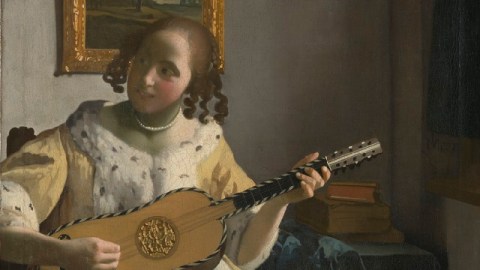How to See and Hear Vermeer

Many of Johannes Vermeer’s most famous paintings seem almost eerily silent: The Milkmaid pouring cool milk into a jar, The Lacemaker deep in concentration, the Girl with a Pearl Earring looking fetchingly over her shoulder. But in Vermeer and Music: The Art of Love and Leisure, which runs through September 8, 2013 at the National Gallery, London, we not only see Vermeer—we “hear” him. Through genre pictures of people making music in the home for their own entertainment, Vermeer (and his contemporaries) captured the very sounds of the day in their paintings. Accompanied by musicians playing the music of Vermeer’s time in the galleries with the paintings, Vermeer and Music brings the Dutch master resoundingly to life.
Before stereos, CDs, and iTunes, if you wanted to enjoy music in your home, you had to make it yourself. The rising Dutch merchant class that patronized Vermeer and similar artists possessed the leisure time and disposable income to make sweet music part of their daily life. Artists reflected this reality back to the people through images ranging from individuals playing alone to couples courting via music to full-blown group concert parties. Vermeer and Music beautifully presents the full spectrum of this representation with charming works by Vermeer’s contemporaries, such as Gerrit Dou’s A Woman Playing a Clavichord (ca. 1665), Jan Steen’s A Young Woman Playing a Harpsichord to a Young Man (ca. 1659), Gabriel Metsu’s A Man and a Woman Seated by a Virginal (ca. 1665), Jacob van Velsen’s A Musical Party (1631), and Hendrick ter Brugghen’s The Concert (ca. 1626). This context not only positions the sometimes historically isolated, seemingly magical Vermeer within his community, but it also visually reinforces the powerful influence of Caravaggio, who inspired the so-called Caravaggisti in Holland and across Europe in the 1600s.
But the stars of the show are, of course, the Vermeers—all five of them. Along with the four works featuring a single woman with an instrument (The Guitar Player [ca. 1672], A Young Woman Standing at a Virginal [ca. 1670-1672], A Young Woman Seated at a Virginal [ca. 1670-1672], and Young Woman Seated at a Virginal [ca. 1670-1672]), The Music Lesson (ca. 1662-1663) shows the music master at work (and often on the make). Considering how rare Vermeers are (experts confirm only 34 are by Vermeer, with another three in debate), the National Gallery’s success in getting three loaned to them to add to the two already in their collection makes this a must-see exhibition.
Vermeers are rare for various reasons, some due to the ravages of time, but some also due to Vermeer himself. He worked slowly, meticulously, often on commission, and in addition to other responsibilities to his business and family, resulting in an average of only three paintings per year during his lifetime. So, when you do come face to face with a Vermeer, take your time, just as he did. Take a cursory glance at The Guitar Player (shown above) and you’ll see just a young woman playing a stringed instrument. Young women often took up instruments as part of the game of “refinement” to make them more attractive to suitors. But look more closely and you see the way Vermeer himself “played” the genre in his unique way that separates him from the pack. The strings on the guitar appear blurred, as if just strummed and still vibrating. Vermeer takes the still image and makes it resonate with “still” music. Instead of placing the woman in the center, she’s put off to the left side—a kind of visual syncopation that gives the work a fascinating rhythm. Finally, the beaming expression on the young woman’s face speaks more of individual artistic expression than of hooking a young man’s heart. The Guitar Player truly enjoys playing both for the unseen audience she’s looking towards and, more importantly, for herself. The confidence and creativity of this individualized young woman still captivate audiences, who can only see and imagine hearing her music.
The curators of Vermeer and Music help visitors imagine hearing the music even better by including actual examples of period instruments, such as a lute, guitar, and cittern, as well as sheet music a typical amateur would read. I love that the English title of the songbook The New Improved Pleasure-Garden translates to the Dutch Den nieuwen verbeterden Lust-Hof, with “pleasure” equating “lust.” As Shakespeare wrote in Twelfth Night, “If music be the food of love, play on.” The pleasurable lust for the nurturing power of music plays on thanks to The Academy of Ancient Music, who will perform every Thursday, Friday and Saturday in the exhibition among the paintings. The AAM will play on authentic instruments works by native Netherlandish composers such as Jan Pieterszoon Sweelinck, Willem de Fesch, and Joannes Florentius a Kempis as well as foreign imports such as the Italian Arcangelo Corelli that Vermeer’s generation would have known and heard. It all adds up to a multimedia experience to fill the senses and make the art, the artists, and their subjects burst into life.
Like Shakespeare, Vermeer remains a tantalizing cipher. As much as we try to piece together a life story for those two artists from the scraps of documentation passed down, we’ll never really know more about either of them outside of their art. Vermeer and Music: The Art of Love and Leisure brings you closer not just to Vermeer the artist, but also to Vermeer the person—living and loving and experiencing the pleasure of music. If music is the food of love, Vermeer and Music will fill you up and still leave you hungry for more.
[Image:Johannes Vermeer (1632-1675). The Guitar Player, about 1672. Oil on canvas. 53 x 46.3 cm. On loan from English Heritage, The Iveagh Bequest (Kenwood). © English Heritage.]
[Many thanks to the National Gallery, London, for providing me with the image above and other press materials related to Vermeer and Music: The Art of Love and Leisure, which runs through September 8, 2013.]





